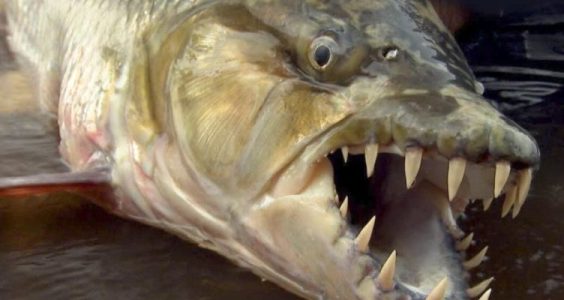 Forget pirhanas. Never mind the great white shark. This fish is the stuff of nightmares! It is said to be the most dangerous freshwater fish in the world. The Goliath Tigerfish has a mouthful of 32 jagged, razorlike teeth, which are said to be as long and sharp as those of the great white shark's. And unlike the South American piranha, the tigerfish has teeth set right at jaw's edge. These can literally slice prey in half, with one clean, surgical cut. They have a double hinged jaw; this means they are able to open their jaws a lot wider than other fish, and as a result its teeth point further forward when it strikes prey, allowing it to take chunks from their flesh.  This species of Tigerfish, the biggest of the Tigerfish family, is found in the freshwater Congo River Basin in Africa, including Lake Tanganyika and the Lualaba River. Powerful jaws, combined with lightning reflexes and a muscular physique, make the Goliath a lethal hunting machine. It prefers turbulent waters, where its top speed of 40 km/h allows it to target fish that are less powerful swimmers. Goliaths have also been seen leaping out of the water to snag birds in flight. The Goliath Tigerfish is known to attack larger animals, including crocodiles, humans, and of course other fish. The largest ever caught measured 1.5 metres long and weighed 70 kilograms. Locals say it is the only fish that has no fear of the crocodile, attacking and eating the smaller ones. Special organs help it detect small vibrations and its eyesight is particularly good, although attacks on humans could have been the result of mistaking human jewellery or accessories for the flash and splash of smaller fish. Nevertheless, it is the only freshwater fish in Africa with documented attacks on humans. The Goliath Tigerfish has few known predators, due to their size and ferocity, except perhaps for larger crocodiles. However, they are a widely-prized game fish and are therefore hunted by humans. Female Goliath Tigerfish choose riverbanks or lakeshores to lay their eggs. Eggs are laid in underwater vegetation to protect them from predators as the young are not cared for by the parent fish. The females lay a large number of eggs in order to increase the chances that some will survive to adulthood, sometimes up to as many as 750,000. 
 |